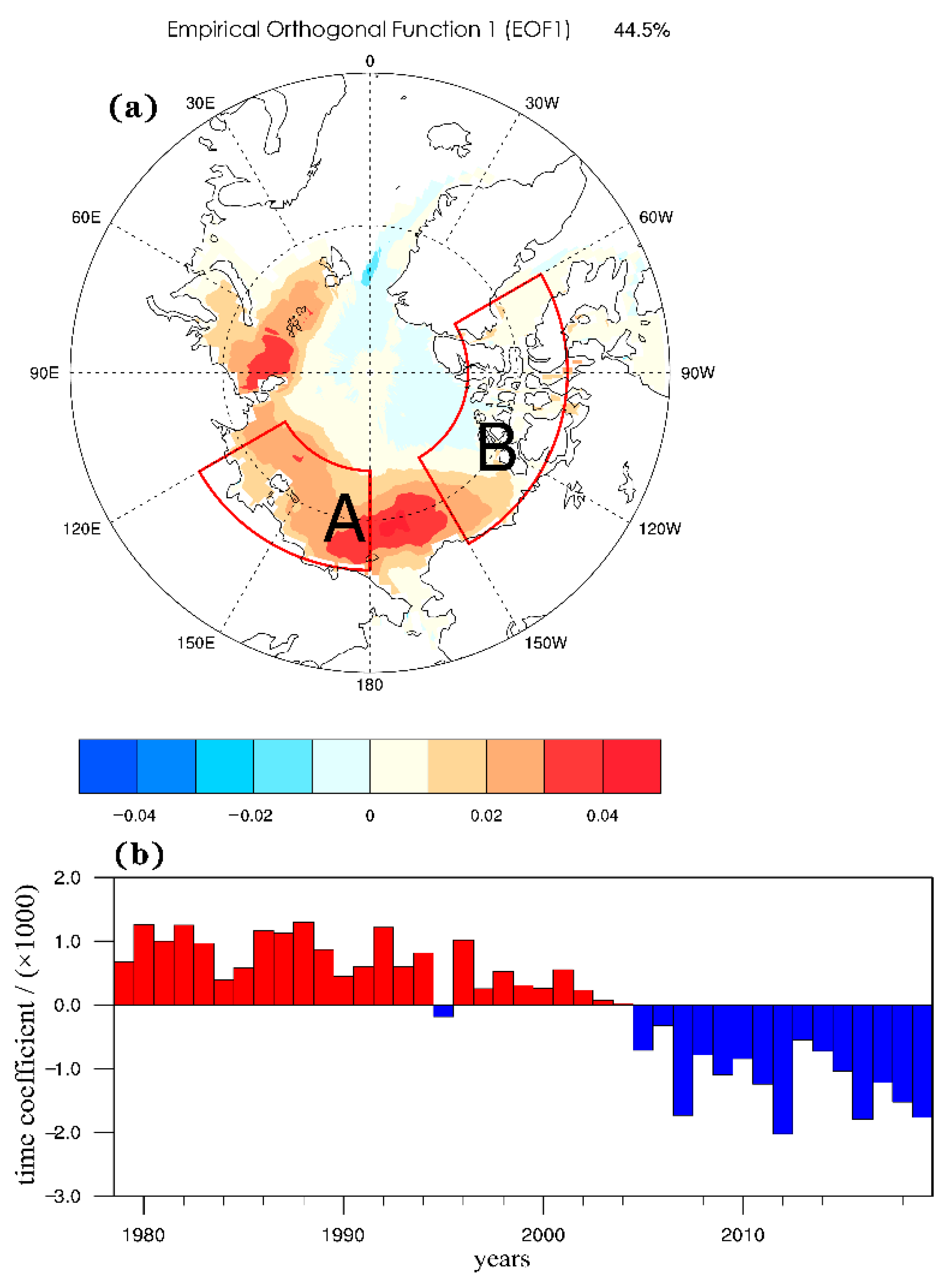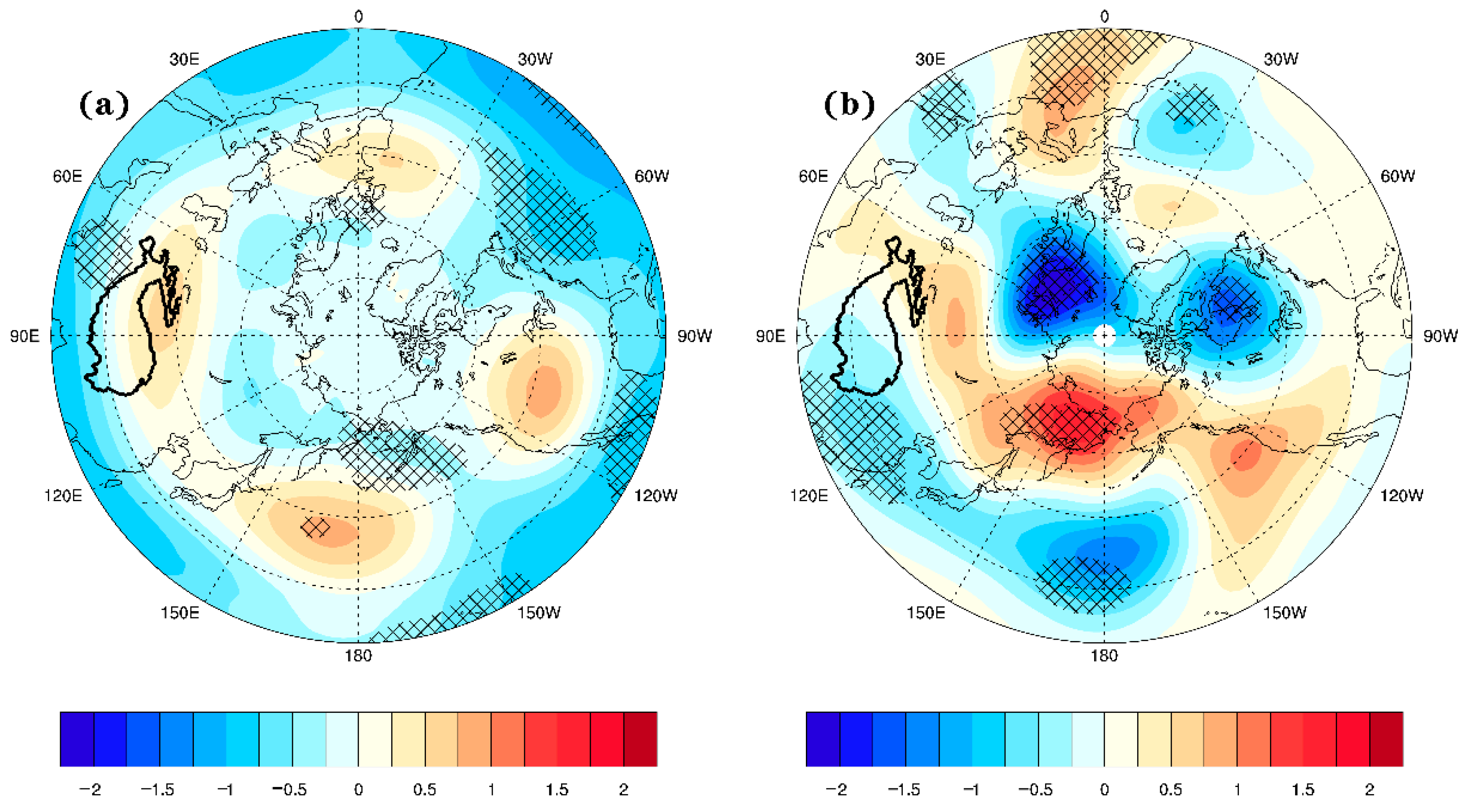Can Arctic Sea Ice Influence the Extremely Cold Days and Nights in Winter over the Tibetan Plateau?
Abstract
:1. Introduction
2. Materials and Methods
2.1. Data and Statistical Methods
2.2. Community Atmosphere Model, Version 5.1.1 (CAM5.1.1) Simulations
3. Results
3.1. Changes in Sea Ice Concentration in the Arctic
3.2. Relationship between Arctic Sea Ice Concentration and Extremely Low Temperature in the TP
3.3. Possible Mechanisms
4. Conclusions and Discussion
Author Contributions
Funding
Institutional Review Board Statement
Informed Consent Statement
Acknowledgments
Conflicts of Interest
References
- Maslanik, J.A.; Fowler, C.; Stroeve, J.; Drobot, S.; Zwally, J.; Yi, D.; Emery, W. A younger, thinner Arctic ice cover: Increased potential for rapid, extensive sea ice loss. Geophys. Res. Lett. 2007, 34, 497–507. [Google Scholar] [CrossRef] [Green Version]
- Bader, J.; Mesquita, M.D.S.; Hodges, K.I.; Keenlyside, N.; Østerhus, S.; Miles, M. A review on Northern Hemisphere sea-ice, storminess and the North Atlantic Oscillation: Observations and projected changes. Atmos. Res. 2011, 101, 809–834. [Google Scholar] [CrossRef]
- Perovich, D.K.; Polashenski, C. Albedo evolution of seasonal Arctic sea ice. Geophys. Res. Lett. 2012, 39, 142–148. [Google Scholar] [CrossRef]
- Intergovernmental Panel on Climate Change. Special Report on the Ocean and Cryosphere in a Changing Climate; IPCC: Geneva, Switzerland, 2019. [Google Scholar]
- Wang, K.; Zhang, T.J.; Mu, C.C.; Zhong, X.Y.; Peng, X.Q.; Cao, B.; Lu, L.; Zheng, L.; Wu, X.D.; Liu, J. From the Third Pole to the Arctic: Changes and impacts of the climate and cryosphere. J. Glaciol. Geocryol. 2020, 42, 104–123. [Google Scholar]
- Lenton, T.M.; Held, H.; Kriegler, E.; Hall, J.W.; Lucht, W.; Rahmstorf, S.; Schellnhuber, H.J. Tipping elements in the Earth’s climate system. Proc. Natl. Acad. Sci. USA 2008, 105, 1786–1793. [Google Scholar] [CrossRef] [Green Version]
- Petoukhov, V.; Semenov, V.A. A link between reduced Barents-Kara sea ice and cold winter extremes over northern continents. J. Geophys. Res. Atmos. 2010, 115, 6128. [Google Scholar] [CrossRef]
- Francis, J.A.; Vavrus, S.J. Evidence linking Arctic amplification to extreme weather in mid-latitudes. Geophys. Res. Lett. 2012, 39, 1017–1029. [Google Scholar] [CrossRef]
- Overland, J.E.; Wang, M. Large-scale atmospheric circulation changes are associated with the recent loss of Arctic sea ice. Tellus Ser. Adynamic Meteorol. Oceanogr. 2010, 62, 1–9. [Google Scholar] [CrossRef] [Green Version]
- Chen, Y.H.; Duan, A.M.; Li, D.L. Connection between winter Arctic sea ice and west Tibetan Plateau snow depth through the NAO. Int. J. Climatol. 2020, 41, 846–861. [Google Scholar] [CrossRef]
- Screen, J.A.; Simmonds, I. Increasing fall-winter energy loss from the Arctic Ocean and its role in Arctic temperature amplification. Geophys. Res. Lett. 2010, 37, 127–137. [Google Scholar] [CrossRef] [Green Version]
- Liu, J.; Curry, J.A.; Wang, H.; Song, M.; Horton, R.M. Impact of declining Arctic sea ice on winter snowfall. Proc. Natl. Acad. Sci. USA 2012, 109, 4074–4079. [Google Scholar] [CrossRef] [PubMed] [Green Version]
- Peings, Y.; Magnusdottir, G. Response of the wintertime Northern Hemisphere atmospheric circulation to current and projected Arctic sea ice decline: A numerical study with CAM5. J. Clim. 2014, 27, 244–264. [Google Scholar] [CrossRef] [Green Version]
- Zhang, R.N.; Sun, C.; Zhang, R.H.; Jia, L.W.; Li, W.J. The impact of Arctic sea ice on the inter-annual variations of summer Ural blocking. Int. J. Climatol. 2018, 38, 4632–4650. [Google Scholar] [CrossRef]
- Screen, J.A.; Simmonds, I. The central role of diminishing sea ice in recent Arctic temperature amplification. Nature 2010, 464, 1334–1337. [Google Scholar] [CrossRef] [PubMed] [Green Version]
- Li, L.; Guan, Z.Y.; Cai, J.X. Interannual variation of winter temperature difference between polar and equatorial regions associated with East Asian climate anomalies. Chin. Sci. Bull. 2014, 59, 2720–2727. [Google Scholar] [CrossRef]
- Jiao, Y.; You, Q.L.; Lin, H.B.; Min, J.Z. Relationship of Arctic sea ice coverage anomalies in summer−autumn and extreme cold days over the Tibetan Plateau in autumn–winter and the mechanism. Clim. Environ. Res. 2017, 22, 435–445. (In Chinese) [Google Scholar]
- Wu, B.; Bian, L.; Zhang, R. Effects of the winter AO and the Arctic sea ice variations on climate variation over East Asia. Chin. J. Polar Res. 2004, 16, 211–220. [Google Scholar]
- Honda, M.; Jun, I.; Shozo, Y. Influence of low Arctic sea ice minima on anomalously cold Eurasian winters. Geophys. Res. Lett. 2009, 36, L08707. [Google Scholar] [CrossRef]
- Hopsch, S.; Cohen, J.; Dethloff, K. Analysis of a link between fall Arctic sea ice concentration and atmospheric patterns in the following winter. Tellus A Dyn. Meteorol. Oceanogr. 2012, 64, 18624. [Google Scholar] [CrossRef] [Green Version]
- Xie, Y.K.; Liu, Y.Z.; Huang, J.P. The influence of the autumn arctic sea ice on winter air temperature in China. Acta Meteorol. Sin. 2014, 72, 703–710. [Google Scholar]
- Qiu, J. China: The third pole. Nat. News 2008, 454, 393–396. [Google Scholar] [CrossRef] [PubMed] [Green Version]
- Liu, X.D.; Baode, C. Climatic warming in the Tibetan Plateau during recent decades. Int. J. Climatol. 2000, 20, 1729–1742. [Google Scholar] [CrossRef]
- Yang, K.; Wu, H.; Qin, J.; Lin, C.; Tang, W.; Chen, Y. Recent climate changes over the Tibetan Plateau and their impacts on energy and water cycle: A review. Glob. Planet. Chang. 2014, 112, 79–91. [Google Scholar] [CrossRef]
- Qiu, J. Trouble in Tibet. Nat. News 2016, 529, 142. [Google Scholar] [CrossRef] [Green Version]
- Wang, C.; Yang, K.; Li, Y.L.; Wu, D.; Bo, Y. Impacts of spatiotemporal anomalies of Tibetan Plateau snow cover on summer precipitation in eastern China. J. Clim. 2017, 30, 885–903. [Google Scholar] [CrossRef]
- Wang, Z.; Yang, S.; Lau, N.C.; Duan, A. Teleconnection between summer NAO and East China rainfall variations: A bridge effect of the Tibetan Plateau. J. Clim. 2018, 31, 6433–6444. [Google Scholar] [CrossRef]
- Gao, J.; Yao, T.; Masson-Delmotte, V.; Steen-Larsen, H.C.; Wang, W. Collapsing glaciers threaten Asia’s water supplies. Nature 2019, 565, 19–21. [Google Scholar] [CrossRef] [Green Version]
- Yao, T.D.; Piao, S.L.; Shen, M.G.; Gao, J.; Yang, W.; Zhang, G.Q.; Lei, Y.B.; Gao, Y.; Zhu, L.P.; Xu, B.Q.; et al. Chained Impacts on Modern Environment of Interaction between Westerlies and Indian Monsoon on Tibetan Plateau. Bull. Chin. Acad. Sci. 2017, 32, 976–984. [Google Scholar]
- You, Q.L.; Cai, Z.Y.; Pepin, N.; Chen, D.L.; Ahrens, B.; Jiang, Z.H.; Wu, F.Y.; Kangz, S.C.; Zhang, R.N.; Wu, T.H.; et al. Warming amplification over the Arctic Pole and Third Pole: Trends, mechanisms and consequences. Earth-Sci. Rev. 2021, 217, 103625. [Google Scholar] [CrossRef]
- Shi, S.B.; Zhang, T.F.; Ma, Z.L.; Li, W.Z.; Yang, Y.H. Variation characteristics of cold air processes in northeastern Tibetan Plateau. Arid Land Geogr. 2019, 42, 232–243. [Google Scholar]
- Zhao, F.; Xiong, A.; Zhang, X.Y. Technical Characteristics of the Architecture Design of China Integrated Meteorological Information Sharing System. J. Appl. Meteorol. Sci. 2017, 28, 750–758. [Google Scholar]
- Parker, D.E.; Folland, C.K.; Bevan, A.C.; Ward, M.N.; Jackson, M.; Maskell, K. Marine surface data for analysis of climatic fluctuations on interannual-to-century time scales. In Natural Climate Variability on Decade-to-Century Time Scales; Martinson, D.G., Ed.; National Academy Press: Washington, DC, USA, 1995; pp. 123–152. [Google Scholar]
- Braud, I.; Obled, C.; Phamdinhtuan, A. Empirical orthogonal function (EOF) analysis of spatial random fields: Theory, accuracy of the numerical approximations and sampling effects. Stoch. Hydrol. Hydraul. 1993, 7, 146–160. [Google Scholar] [CrossRef]
- Peterson, T.C. Climate Change Indices. WMO Bull. 2005, 54, 83–86. [Google Scholar]
- Andrews, D.G.; Holton, J.R.; Leovy, C.B. Middle Atmospheric Dynamics; Academic Press: New York, NY, USA, 1987. [Google Scholar]
- Neale, R.B.; Chen, C.C.; Gettelman, A.; Lauritzen, P.P.; Park, S.; Williamson, D.W.; Conley, A.J.; Garcia, R.; Kinnison, D.; Lamarque, J.F.; et al. Description of the NCAR Community Atmosphere Model (CAM 5.0); NCAR Technical Note NCAR/TN-486 + STR; NCAR: Boulder, CO, USA, 2012; 298p. [Google Scholar]
- Kay, J.E.; Holland, M.M.; Bitz, C.M.; Blanchard-Wrigglesworth, E.; Gettelman, A.; Conley, A.; Bailey, D. The influence of local feedbacks and northward heat transport on the equilibrium Arctic climate response to increased greenhouse gas forcing. J. Clim. 2012, 25, 5433–5450. [Google Scholar] [CrossRef]
- Song, M.R.; Wang, S.Y.; Zhu, Z.; Liu, J.P. Nonlinear changes in cold spell and heat wave arising from Arctic sea-ice loss. Adv. Clim. Chang. Res. 2021, 12, 553–562. [Google Scholar] [CrossRef]
- Wu, F.M.; He, J.H.; Qi, L. Arctic Sea ice declining and its impact on the cold Eurasian winters: A review. Adv. Earth Sci. 2014, 29, 913–921. [Google Scholar]
- Chen, H.W.; Zhang, F.; Alley, R.B. The robustness of midlatitude weather pattern changes due to Arctic sea ice loss. J. Clim. 2016, 29, 7831–7849. [Google Scholar] [CrossRef]
- Screen, J.A. Simulated atmospheric response to regional and pan-Arctic sea ice loss. J. Clim. 2017, 30, 3945–3962. [Google Scholar] [CrossRef] [Green Version]
- Chen, H.W.; Alley, R.B.; Zhang, F. Interannual Arctic sea ice variability and associated winter weather patterns: A regional perspective for 1979–2014. J. Geophys. Res. Atmos. 2016, 121, 14433–14455. [Google Scholar] [CrossRef] [Green Version]
- Screen, J.A.; Deser, C.; Smith, D.M.; Zhang, X.D.; Blackport, R.; Kushner, J.; Oudar, T.; McCusker, K.; Sun, L. Consistency and discrepancy in the atmospheric response to Arctic sea-ice loss across climate models. Nat. Geosci. 2018, 11, 155–163. [Google Scholar] [CrossRef]












| Cold Index of Extreme Temperature | Definition (Unit: Day) |
|---|---|
| The number of cold days (TX10P) | Days with daily maximum temperature less than 10% percentile (The quantile is based on the period from 1981 to 2010) |
| The number of cold nights(TN10P) | Days with daily minimum temperature less than 10% percentile (The quantile is based on the period from 1981 to 2010) |
Publisher’s Note: MDPI stays neutral with regard to jurisdictional claims in published maps and institutional affiliations. |
© 2022 by the authors. Licensee MDPI, Basel, Switzerland. This article is an open access article distributed under the terms and conditions of the Creative Commons Attribution (CC BY) license (https://creativecommons.org/licenses/by/4.0/).
Share and Cite
Jiao, Y.; Zhang, Y.; Hu, P. Can Arctic Sea Ice Influence the Extremely Cold Days and Nights in Winter over the Tibetan Plateau? Atmosphere 2022, 13, 246. https://doi.org/10.3390/atmos13020246
Jiao Y, Zhang Y, Hu P. Can Arctic Sea Ice Influence the Extremely Cold Days and Nights in Winter over the Tibetan Plateau? Atmosphere. 2022; 13(2):246. https://doi.org/10.3390/atmos13020246
Chicago/Turabian StyleJiao, Yang, Yuqing Zhang, and Peng Hu. 2022. "Can Arctic Sea Ice Influence the Extremely Cold Days and Nights in Winter over the Tibetan Plateau?" Atmosphere 13, no. 2: 246. https://doi.org/10.3390/atmos13020246






